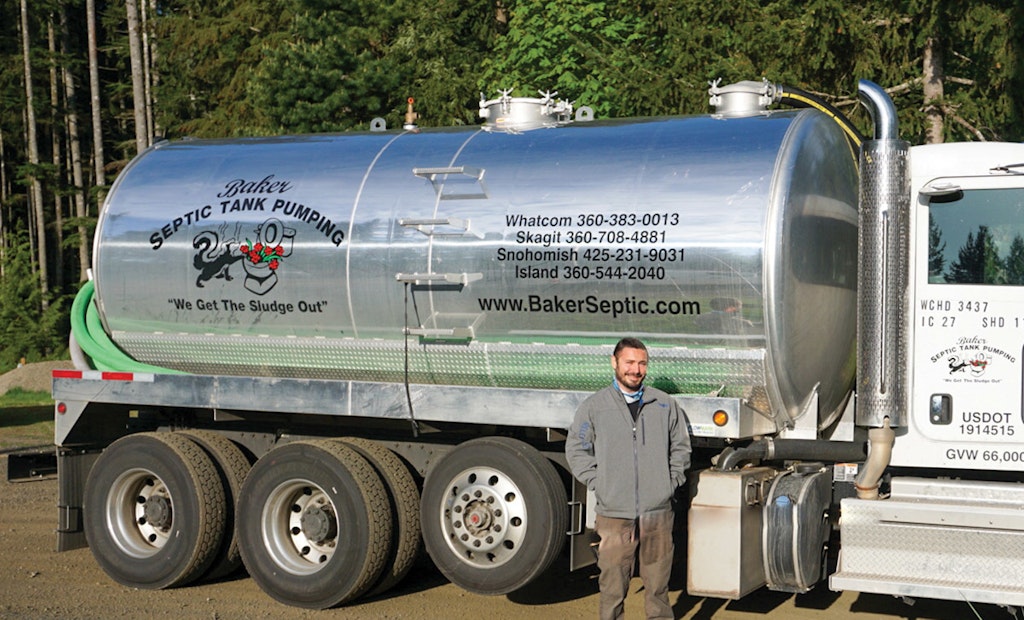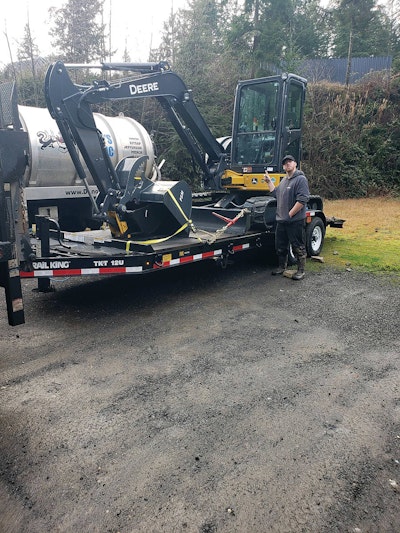
Justin Wells and a 2021 Peterbilt with a FlowMark Vacuum Trucks 4,200-gallon aluminum tank and National Vacuum Equipment 900-cmf blower.
In Snapshot, we talk to a member of a state, provincial or national trade association in the decentralized wastewater industry. This time we visit a member of Washington On-Site Sewage Association.
Name and title or job description: Justin Wells, president and co-owner
Business name and location: Baker Septic, Ferndale, and Dano’s Septic, Bremerton, Washington; Best Septic, Eugene, Oregon
Services we offer: Pumping, installs, inspections, maintenance, repairs and portable sanitation
Age: 35
Years in the industry: 35 — well, sort of. My grandfather started a septic company the year I was born. I grew up third generation in the industry. My grandfather sold the company to my now-partners, and I bought back my portion to keep it in the family. We then started to expand and now have three companies in two states.
Association involvement: I have been teaching classes with the Washington On-Site Sewage Association for three years and have been a member since 2008.
Benefits of belonging to the association: I have met some amazing people with some brilliant ideas. This has taught me tricks, made partnerships and allowed me to see things outside my bubble. I have learned many ways to improve my practices while also helping others do the same. Additionally, knowing what is happening and having a voice with legislation and regulations has made a huge impact in my organizations.
Biggest issue facing our association right now: Lack of designers below the age of 55. Becoming a designer requires an internship or years in school. Most who spend that time in school do not know about the benefits of specializing in the onsite industry. And most who are in the industry do not have the time or chance to intern for the length of time currently required.
Our crew includes: My companies are co-owned by Tom Strain, Julie Strain and Phil Merwin. Our septic managers include Jake Shoemaker, Jon O’Connell and Adam Wahlund. Tony Schnackenburg is our fleet, yard and portable restroom manager. Lisa Hanley is marketing manager. Emma Lindemann, Tarrin Smith, Jeanette Mix and Serena Kelly manage our offices. Jean Bates and Tricia Plymale manage our back end as well as installations. In total we have approximately 70 amazing employees and we could not do it without such a fantastic team.
Typical day on the job: I check in on my management team and work with each of them to assist with any issues. I work through the numbers in our books. I travel biweekly to each company and spend time with them. I try to be in on every review and interview personally. I work with my teams one on one as much as possible to continue their training and education on the job. I take calls from employees as they have issues troubleshooting or quoting strange situations.
The job I’ll never forget: I started running a dye test on an old gravity septic system using green dye. About 10 minutes later the neighbor came over and asked me what I was doing. I explained I was inspecting the system. They said they were wondering because the water coming out of their garden hose was bright green. Needless to say, that system was replaced.
My favorite piece of equipment: Tablets and phones! They allow me to effectively communicate with my team. They take video and pictures that really do say 1,000 words. They have programs that allow us to use less paper and stay organized.
Most challenging site I’ve worked on: Many years ago a restaurant called for a leaking pipe cleanup under the restaurant. It was an old building in a downtown area and there was no access to get under the building. I learned that this sink had a leaking pipe 11 years prior and the restaurant owner decided to not fix it. So I was facing 11 years of leaking sink grease under a building with no access. I had to cut holes in the floor to access the different areas under the floor. There was 12 to 18 inches of molding grease covering a dirt floor in about a 4,000-square-foot area. The space was about 28 inches tall and in some places as shallow as 8 inches. To add to it all, the only place to park a truck was on the main road so all work had to happen after midnight and wrap up by 5 a.m. per the city. I spent three nights on my belly in that 11-year-old molding grease. After about 3 hours it became clear that the most effective way to vacuum it up was to lay on my belly and use my arms in a swimming motion to pull it to the end of the vacuum hose and push it in by hand. Three long nights later the area was cleaned and sanitized.
Oops, I wish I could take this one back: I took a pumping job for a large system serving a trailer park. They called me because no one else would accept the job. It was a 3.5-hour drive to get to the site. The tank was a massive 25,000 gallons. The only access was 6 feet of riser over one section of the tank. I brought two 4,000-gallon trucks with a game plan to pump and backflush my way through it. When I arrived and put my hose in, it bounced off of the scum layer because it was so hard and full of trash. We stayed at a hotel and spent four days pumping and attempting to break up the solid matter. At day four it was clear we were not going to be able to remove it all from the tank. I was unable to charge the customer and lost all that labor and time. I will not do commercial or large systems sight unseen again. Lesson learned.
The craziest question I’ve been asked by a customer: I had someone ask me if the slow toilet could be because the septic tank had septic rats — “You know, like sewer systems.”
If I could change one industry regulation, it would be: I would make it easier for onsite professionals to get a license to install floats and pumps.
Best piece of small business advice I’ve heard: Being right doesn’t mean you win.
If I wasn’t working in the wastewater industry, I would: Be a cook. I love to cook and enjoy the fast-paced restaurant environment.
Crystal ball time — This is my outlook for the wastewater industry: There’s a hope I have for the industry, and I sometimes bring this up in my educational classes as a challenge. It breaks my heart when I hear, “I wish I was on sewer,” or, “I’m not going to buy this house because it’s on septic.” I want us to look at the end user more with our innovations. We have innovated our way out of so many issues, but it typically involves regulations. We have made unbuildable sites safe to build on and have an onsite system. But people still are told the do’s and don’ts of septic — don’t do your laundry all on Saturday, don’t flush wipes, don’t have a garbage disposal, don’t use those products — don’t, don’t, don’t. “Live your life around your toilet,” is what they hear. So my hope is that we can start to innovate and regulate in a way that people can live their life the way someone not on a septic system can and not pay the price for doing so. I believe if we try, we can achieve this.






